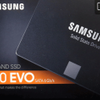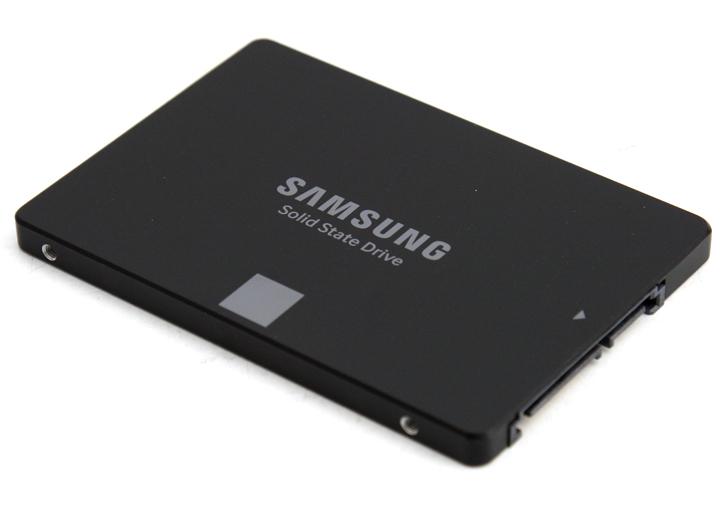Final Words & Conclusion
Final Words & Conclusion
There can be no conclusion other than the fact the new Samsung 860 EVO shows green lights everywhere, and checks all the right boxes. It is getting rather saturated in the SATA3 arena and the performance difference is becoming more marginal at best. To address that, Samsung is now focussing a bit more on bigger volume sizes, endurance in Terabytes written and sure, a slight bump in performance as well. If we throw in the 850 EVO and 750 EVO purely based on performance, you'll have a hard time spotting a difference. Long sustained writes rock though, and the 860 EVO surely is plenty fast capping out the limits of that SATA3 port. What I like best is a bit more endurance in terms of TBW and the 5-year warranty.
Endurance and lots of caches
Samsung makes use of a properly sized DRAM cache. 512 MB for the 250 and 500 GB version, the 1 TB gets 1 GB, the 2 TB 2 GB and the 4 TB even gets 4 GB LPDDR4 cache. That is already massive. However, they also apply an SLC write cache. The two combined offer a very good sustained and linear throughput in writing performance. Endurance then; a 500 GB Series 860 is now guaranteed at 300 TBW, and that is really nice. Doubling up the volume sizes also doubles up that TBW value, so that is 600 TBW (Terabytes written) for a 1 TB version, 1200 TBW for today's tested 2 TB version, and sure, even 2400 TBW for that massive 4 TB version. That is plenty. Given MLC's written nature and if you write, say, 20 GB a day / 365 days a year that would be 7.3 TB per year. With a 500 GB model that is over 40 years of lifespan, we're fairly certain the controllers turn to sand by then, but still. The ever so important factor, of course, is price, you'll be able to spot this unit at just over 30 cents per GB for our tested 2 TB model, and that makes this unit amongst the cheaper ones on the market (but not the cheapest). The EVO is considered to be mainstream, mid-range. Mid-range these days is last year's high-end performance. And with this kind of performance, you overall remain in the high-end segment on SATA3.
The 860 EVO is also very fast as it was able to stay on top of pretty much all tests we fired at it from our benchmark suite. This is in the top 5 tested SSDs performance wise and to see high-end performance with such consistency shows that this SSD is done right. Next to that, we just have to touch on the topic of power consumption. The power consumption of the Samsung SSD is low as well with an IDLE rating of 50 mW, and roughly 3 Watts when in use.
Performance
This SSD writes and reads serious amounts of tiny files in a fast enough fashion. You can often notice a drop-off point once the caches really run out of stamina, but you will need to have written many GBs before that happens, and even then you are still looking at a "slow" 400 MB/sec. IOPS is not something you as a consumer should worry about too much unless you are doing a lot of database related work or create similar workloads on your PC, but this SSD certainly ranks high within this aspect. Trace testing - we think by far the best test in our entire benchmark suite is PCMark. This is a trace test and can emulate what you guys do on your PC but then multiply it by a factor of 100, this test puts more focus on read performance opposed to writing though. Zoom in at both IOPS and trace performance and you'll notice that the SSD can manage serious workloads without breaking so much as a drop of sweat. So whether you write lots of small files, copy MKV movies or do it all together, the SSD remains a solid performer on all fronts.
Overall
Right, an or any SSD anno 2018 is enjoyable. Very much so. If you put a drive like this into your SATA 3 compatible laptop or SATA 3 compatible PC, you'll have no idea what is about to hit you when comparing with a HDD. We very much enjoy the grand sustained performance of this SSD series. Make no mistake, replacing an HDD with an SSD in your desktop PC or laptop eliminates the random access lag of the HDD head, it is no longer mechanical. That, combined with the maxed out performance SATA 3 offers these days, is simply a massive difference and probably the best upgrade you can make for your computer this day and age.
Your SATA controller
Some overall recommendations then. Should you be in the market for a SATA3 SSD then we have a couple of hints. First and foremost if you have a SATA 2 controller only on your motherboard, then you'll be limited at roughly 270 MB/sec read and writes. SATA3 (6 Gbps) will free you up from that allowing the SSD to perform in the 500 MB/sec range. It is, however, important that you connect your SSD to the proper controller. Internal chipset-based integrated SATA 6G controllers are the best thus, say, the Z270 / Z370 / X299 Intel SATA3 interface or the AMD X370 / X399 internal chipset interface. If you run the SSD from a 3rd party controller like, say, a Marvell / ASMedia 6G controller, you will often see lower performance. The new AMD chipsets offer fantastic performance btw. The more recent Asmedia controllers we spotted lately on motherboards also offer good performance, albeit still 20% ~ 25% slower than Intel's controllers. Also, make sure you run your drive in AHCI mode, it does make such a difference in performance, a big difference.
Price point
Fabbing your own controller, your own PCB, your own cache chips and own NAND flash memory does have advantages as Samsung is able to keep the prices very competitive as this product is made 99% in-house...
- 4 TB - $1399.99 = 34 cent/GB
- 2 TB - $649.99 = 32 cent/GB
- 1 TB - $329.99 = 32 cent/GB
- 500 GB - $169.99 = 34 cent/GB
- 250 GB - $94.99 = 38 cent/GB
So yes, prices are not that cheap really, 329 USD for the 1 TB model, our tested 2 TB model already runs to 649 USD. So that's over 30 cents per GB. Then again these are suggested retail prices, not street prices. I also must add that the NAND is MLC written, your warranty is 5 years and endurance values have moved upwards. The prices could come down a bit more (IMHO) though.
Concluding
The new 860 EVO series could have been king of the budget, but at its current pricing that crown remains to be in Crucial's hands with their MX500 series at 26 cents per GB for a similar sized SSD. Samsung tweaked the controller a bit and applied new vertically stacked NAND, 64-layers of them. This results in SSDs ranging from 250 GB up-to a staggering 4 TB. Our tested 2 TB version simply offers fantastic performance, continuously in that 500 MB/s sweet spot. The choice of 64-layer V-NAND helps Samsung in write performance as well, but they also armed it with dual-caches and the combination of it all seems to be a very solid one. Only street prices based on volume availability will define the sales price and thus are the decisive factor, aside from what I hoped to be a slightly cheaper SSD the lights are all green on this one from what we see right now. Performance wise it's mostly, all the same, these days, ergo the biggest move in the storage industry right now is the quest for more capacity and proper endurance with SATA3 6 Gbit/s storage units. The Samsung 860 EVO series now also comes with a proper five-year warranty. In closing, we have to admit, this is a properly good SATA3 SSD. You'll receive high-end performance for a SATA3 SSD positioned in that somewhat value segment (price could/should be a notch better), armed with proper endurance levels. We expect the Series 860 EVO SSDs to become popular ones, definitely recommended.
Recommended Downloads
- Sign up to receive a notice when we publish a new article
- Or go back to Guru3D's front page


